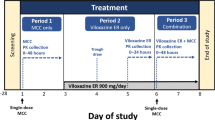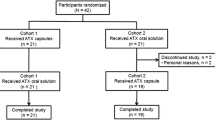Abstract
Objectives
The main objective of the present study was to provide information on whether static and dynamic pupillometry can be used for pharmacodynamic profiling, particularly when investigating opioid-like drugs, such as tramadol.
Methods
Healthy subjects (n=26) participated in this randomised, double-blind, placebo-controlled, crossover Phase 1 study. Of these, 20 extensive metabolisers (EMs) with respect to polymorphic isoenzyme cytochrome P450 2D6 (CYP2D6) received up to 150 mg of tramadol–HCl and placebo. The 6 poor metabolisers (PMs) with respect to CYP2D6 received 100 mg tramadol–HCl and placebo.
Results
In EMs, serum concentrations of the enantiomers of tramadol and of O-demethylated metabolite (M1) increased with increasing doses. Comparing the 100-mg dose between EMs and PMs, the latter exhibited higher serum concentrations of both enantiomers of tramadol. Serum concentrations of (+)-M1 remained below the lower limit of quantification, and that of (−)-M1 were lower than those in EMs. In EMs, doses from 100 mg tramadol–HCl on induced a significant (P<0.05) miosis as compared with placebo. The maximum mean differences from placebo after dosing with 50, 100 and 150 mg tramadol–HCL were −0.5, −0.8 and −1.1 mm, respectively, indicating a dose-dependent character of the changes. Dynamic pupillometry revealed significant (P<0.05) effects for the amplitude, latency and duration of reaction. The amplitude and velocity of constriction were decreased only at the highest dose; whereas, the changes of the amplitude reached statistical significance (P<0.05). Both the latency and reaction duration behaved in a dose-dependent manner. For the latency, significant changes compared with placebo (P<0.05) were found at the 150-mg dose level, while the reaction duration was already significantly (P<0.05) decreased from the 100-mg dose on. The velocity of redilatation did not respond at all. In PMs, no effect on the initial pupil diameter was found. Although the statistical analysis failed to demonstrate any significant change from placebo for the dynamic pupillometry, the effect-time profiles of EMs and PMs were comparable. For both metaboliser groups, a decrease of amplitude, velocity of constriction and reaction duration as well as an increase of latency was observed. In principle, the direction and magnitude of changes were comparable between EMs and PMs. Most important was the finding that the time course of effects was completely different between both groups of metabolisers. In EMs, effects slowly reached a maximum between 4 h and 10 h after dosing and diminished until 24 h; whereas, in PMs, both maximum effects and the return to baseline occurred much earlier, at approximately 3 h and 8 h, respectively.
Conclusions
The EMs and PMs of CYP2D6 treated with tramadol behaved differently in static and dynamic pupillometry. The reason for this could largely be explained with the aid of the metaboliser status and the pharmacokinetic properties of tramadol. In EMs, the pupillometric response was mainly driven by the (+)-M1, which comprises the μ action component of tramadol; whereas, in PMs, the non-μ component appears to play an important role. Thus, pupillometry was found to be useful in pharmacodynamic profiling and provides a good correlation with the pharmacokinetics.



Similar content being viewed by others
References
Reisine T, Pasternak G (1996) Opioid analgesics and antagonists. In: Hardman JG, Limbird LE, Molinoff PB, Ruddon RW, Gilman AG (eds) Goodman and Gilman’s the pharmacological basis of therapeutics. McGraw-Hill Inc., New York, pp 521–555
Weinhold LL, Bigelow GE (1993) Opioid miosis: effects of lighting intensity and monocular and binocular exposure. Drug Alcohol Depend 31:177–181
Pickworth WB, Welch P, Henningfield JE, Cone EJ (1989) Opiate-induced pupillary effects in humans. Methods Find Exp Clin Pharmacol 11:759–763
Peacock JE, Henderson PD, Nimmo WS (1988) Changes in pupil diameter after oral administration of codeine. Br J Anaesth 61:598–600
Pickworth WB, Lee H, Fudala PJ (1990) Buprenorphine-induced pupillary effects in human volunteers. Life Sci 47:1269–1277
Pickworth WB, Bunker E, Welch P, Cone E (1991) Intravenous buprenorphine reduces pupil size and the light reflex in humans. Life Sci 49:129–138
Jasinski DR, Preston KL (1986) Evaluation of tilidine for morphine-like subjective effects and euphoria. Drug Alcohol Depend 18:273–292
Zacny JP, Lichtor JL, Binstock W, Coalson DW, Cutter T, Flemming DC, Glosten B (1993) Subjective, behavioral and physiological responses to intravenous meperidine in healthy volunteers. Psychopharmacology (Berl) 111:306–314
Walker DJ, Zacny JP (1999) Subjective, psychomotor, and physiological effects of cumulative doses of opioid mu agonists in healthy volunteers. J Pharmacol Exp Ther 289:1454–1464
Mansky PA (1978) Opiates: human psychopharmacology. In: Iversen LL, Iversen SD, Snyder SH (eds) Drugs of abuse. Plenum Press, New York, pp 95–185
Clark RF, Wei EM, Anderson PO (1995) Meperidine: therapeutic use and toxicity. J Emerg Med 13:797–802
Lamas X, Farre M, Cami J (1994) Acute effects of pentazocine, naloxone and morphine in opioid-dependent volunteers. J Pharmacol Exp Ther 268:1485–1492
Martin WR, Gilbert PE, Thompson JA, Jessee CA (1978) Use of the chronic spinal dog for assessment of the abuse potentiality and utility of narcotic analgesics and narcotic antagonists. Drug Alcohol Depend 3:23–34
Rolan P (1997) The contribution of clinical pharmacology surrogates and models to drug development—a critical appraisal. Br J Clin Pharmacol 44:219–225
Raffa RB (1996) A novel approach to the pharmacology of analgesics. Am J Med 101:40S–46S
Dayer P, Collart L, Desmeules J (1994) The pharmacology of tramadol. Drugs 47(Suppl 1):S3–S7
Lintz W, Barth H, Osterloh G, Schmidt-Bothelt E (1986) Bioavailability of enteral tramadol formulations—1st communication: capsules. Arzneimittelforschung 36:1278–1283
Raffa RB, Nayak RK, Liao S, Minn FL (1995) The mechanism(s) of action and pharmacokinetics of tramadol hydrochloride. Rev Contemp Pharmacother 6:485–497
Lintz W (1980) Pharmacokinetics of tramadol in man and animals. Naunyn Schmiedebergs Arch Pharmacol 313:R53–R53
Erlacin S, Frankus E, Lintz W (1980) Metabolism of tramadol in man and animals. Naunyn Schmiedebergs Arch Pharmacol 313:R51–R51
Lintz W, Erlacin S, Frankus E, Uragg H (1981) Biotransformation of tramadol in man and animals. Arzneimittelforschung 31:1932–1943
Paar WD, Poche S, Gerloff J, Dengler HJ (1997) Polymorphic CYP2D6 mediates O-demethylation of the opioid analgesic tramadol. Eur J Clin Pharmacol 53:235–239
Bradford LD (2002) CYP2D6 allele frequency in European Caucasians, Asians, Africans and their descendants. Pharmacogenomics 3:229–243
Collart L, Luthy C, Dayer P (1993) Multimodal analgesic effect of tramadol. Clin Pharmacol Ther 53:223–223
Poulsen L, Arendt-Nielsen L, Brosen K, Sindrup SH (1996) The hypoalgesic effect of tramadol in relation to CYP2D6. Clin Pharmacol Ther 60:636–644
Terlinden R, Ossig J, Lintz W (1995) GC/NPD method for stereoselective determination of the enantiomers of tramadol and its metabolite M1 in human serum after derivatisation of M1. Research Report-No. PK 389 Grünenthal Research Centre
Gibaldi M, Perrier D (1982) Pharmacokinetics. Marcel Dekker Inc., New York Basel
Cawello W (1999) Parameters for compartment-free pharmacokinetics. Shaker Verlag GmbH, Aachen
Preston KL, Jasinski DR, Testa M (1991) Abuse potential and pharmacological comparison of tramadol and morphine. Drug Alcohol Depend 27:7–17
Knaggs RD, Crighton IM, Cobby TF, Fletcher AJ, Hobbs GJ (2004) The pupillary effects of intravenous morphine, codeine, and tramadol in volunteers. Anesth Analg 99:108–112
Krueger H, Muller-Limmroth W (1978) Algo-pupillometric investigation of the analgesic effect of tramadol. Arzneimittelforschung 28:176–178
Freye E, Latasch L (2000) Effects of tramadol and tilidine/naloxone on oral-caecal transit and pupillary light reflex. Arzneimittelforschung 50:24–30
Bergamin O, Schoetzau A, Sugimoto K, Zulauf M (1998) The influence of iris color on the pupillary light reflex. Graefes Arch Clin Exp Ophthalmol 236:567–570
Boxer Wachler BS, Krueger RR (2000) Agreement and repeatability of pupillometry using videokeratography and infrared devices. J Cataract Refract Surg 26:35–40
Kohnen T, Terzi E, Kasper T, Kohnen EM, Buhren J (2004) Correlation of infrared pupillometers and CCD-camera imaging from aberrometry and videokeratography for determining scotopic pupil size. J Cataract Refract Surg 30:2116–2123
Cami J, Lamas X, Farre M (1994) Acute effects of tramadol in methadone-maintained volunteers. Drugs 47(Suppl 1):S39–S43
Zacny JP, Gutierrez S (2003) Characterizing the subjective, psychomotor, and physiological effects of oral oxycodone in non-drug-abusing volunteers. Psychopharmacology (Berl) 170:242–254
Walker DJ, Zacny JP (1998) Subjective, psychomotor, and analgesic effects of oral codeine and morphine in healthy volunteers. Psychopharmacology (Berl) 140:191–201
Acknowledgements
The authors thank Ruth Becker and Dr. Rolf Terlinden for the performance of the bioanalytical determinations and pharmacokinetic calculations, Achim Steup for providing the statistical analyses and Dr. Markus Hinder for the skilful conduct of pupillometry.
Author information
Authors and Affiliations
Corresponding author
Rights and permissions
About this article
Cite this article
Fliegert, F., Kurth, B. & Göhler, K. The effects of tramadol on static and dynamic pupillometry in healthy subjects—the relationship between pharmacodynamics, pharmacokinetics and CYP2D6 metaboliser status. Eur J Clin Pharmacol 61, 257–266 (2005). https://doi.org/10.1007/s00228-005-0920-y
Received:
Accepted:
Published:
Issue Date:
DOI: https://doi.org/10.1007/s00228-005-0920-y




